 By Bob Currie
By Bob Currie
Recreational Boating Safety Specialist
U.S. Coast Guard Auxiliary Station Galveston Flotilla
One of the primary missions of the U.S. Coast Guard Auxiliary is Recreational Boating Safety (RBS). One way we increase RBS is by performing free Vessel Safety Checks. A Vessel Safety Check has two parts. The first part concerns Coast Guard regulations, and the second part concerns Coast Guard recommendations. The COVID69 Pandemic has put a damper on our ability to perform Vessel Safety Checks.
The Station Galveston Flotilla of the US Coast Guard Auxiliary operates out of the USCG Station Galveston base on Galveston Island. They aid the Coast Guard by providing maritime observation patrols in Galveston Bay; by providing recreational boating vessel safety checks; and by working alongside Coast Guard members in maritime accident investigation, small boat training, providing a safety zone, Aids to Navigation verification, in the galley, and watch standing.
This column and the next will cover how you, with a little training from this column, can perform a self-check using the Coast Guard Vessel Safety Check form. Although your self-check will not rise to the quality of an inspection performed by an Auxiliarist, it will give you peace of mind until you can undergo an actual inspection by a Certified Vessel Examiner. The Vessel Safety Check discussed here is for both powered and sail vessels. We have a completely different version for Paddle Craft that will be discussed in another column.
Vessel Safety Check Form
The requirements to get a Vessel Safety Check decal coincide with Coast Guard regulations. These aren’t all the regulations- just the minimum requirements pertaining to vessel safety equipment. If you meet all the requirements when inspected by a Coast Guard Auxiliary Certified Vessel Examiner, you will receive a decal to attach to your boat. Let’s review these requirements so you will understand how to apply them to your boat. The first part of the form we will discuss is the Vessel Information box.
Vessel Information
The information in the Vessel Information box sets the standards by which your boat will be inspected. The regulations are different for (1) boats of different lengths, (2) how the boat is propelled, (3) where the boat is to be operated, and (4) the type of boat.
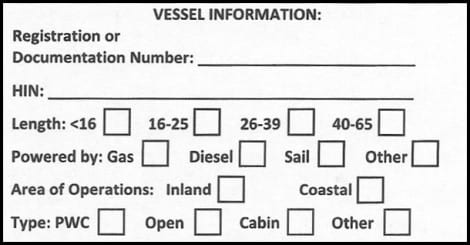
So, step 1 is to classify your boat according to the Vessel Information Box. For example, for my boat I would check 16-25 for length, Powered by Gas, Area of Operations: Coastal, and Type: Open (it’s a center console bay fishing boat).
Vessel Safety Check Decal Requirements Box
Here is the actual checklist of required items. As mentioned, not all boats must meet all 15 items. There are four different ways a boat could be excluded from a requirement: (1) length, (2) method of propulsion, (3) area of operations, and (4) type of boat. For instance, Item 7: Backfire Flame Control only applies to inboard/outboard and inboard boats powered by gas.
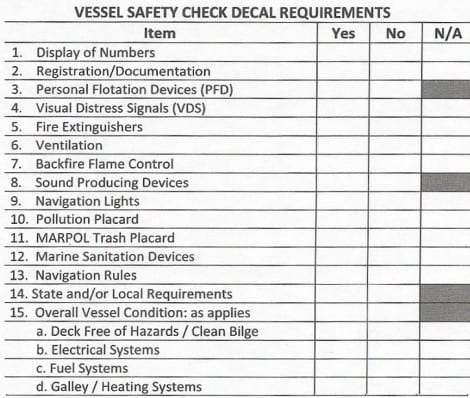
Let’s review each item so that you will have a better understanding of the requirement.
Item 1: Display of Numbers
The boat’s registration number must be permanently attached to each side of the forward half of the boat. Characters must be plain, vertical, block style, not less than three (3) inches high, and in a color contrasting with the background. A space or hyphen must separate the letters from the numbers. Place state validation sticker according to state policy. Well, that is pretty plainly written. See below for an example for Texas. That said, over a quarter of all the boats I see out on the water do not meet this standard.

Item 2: Registration/Documentation
Registration or Documentation papers must be on board and available (in Texas, vessels that are Coast Guard Documented must also be registered, and the registration sticker must be displayed). Documentation numbers must be permanently marked on a visible part of the interior structure. The documented boat’s name and Hailing Port must be displayed on the exterior hull in letters not less than four (4) inches high.
Unless you have a sea going yacht, you probably don’t have to worry about Documentation. However, you must have your actual Texas Boat Registration Card (also called Certificate of Number) available on the boat.
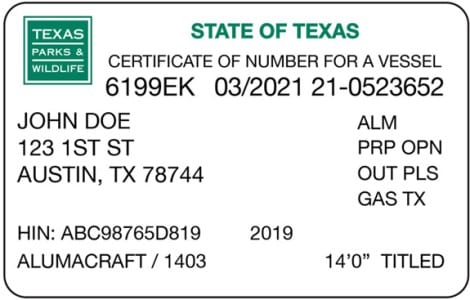
Item 3: Personal Flotation Devices (PFDs)
Acceptable PFDs (also known as Life Jackets) must be U.S. Coast Guard approved and in good, serviceable condition. A wearable PFD of suitable size is required for each person on the boat. Children must have properly fitted PFDs designed for children. Wearable PFDs shall be “readily accessible.” Boats/rowboats 16 feet or longer (except canoes and kayaks) must have one type IV (throwable) device, which shall be “immediately available” (not stowed). PFDs shall NOT be stored in unopened plastic packaging. For Personal Watercraft riders, the PFD must be worn. An impact rating is recommended but not required. Speaking with experience, I highly recommend an impact-rated PFD.

Item 4: Visual Distress Signals
Recreational boats 16 feet and over used on coastal waters or Great Lakes are required to carry a minimum of either (1) three day and three night pyrotechnic devices, (2) one day non-pyrotechnic device (flag) and one night non-pyrotechnic device (auto SOS light), or (3) a combination of (1) and (2). Recreational boats less than 16 feet on coastal waters or the Great Lakes need only carry night visual distress signals when operating from sunset to sunrise.

It is recommended but not required that boats operating on inland waters should have some means of signaling a suitable day and night distress signal. Note that Trinity Bay, Galveston East Bay, and Galveston West Bay are considered coastal waters.
Item 5: Fire Extinguishers
Fire extinguishers are required if one of the following conditions exist: (1) Inboard engine, (2) double bottom hulls not completely sealed or filled with flotation materials, (3) closed living space, (4) Closed stowage compartments that contain flammable materials, or (5) permanently installed fuel tanks. Fire extinguishers must be readily accessible and verified as serviceable. The requirements according to length are:
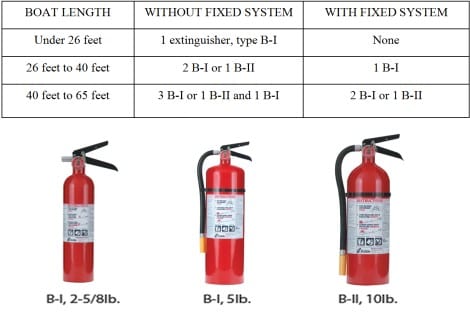
Item 6: Ventilation
Boats with gasoline engines in closed compartments built after 1 August 1980 must have a powered ventilation system. Those built prior to that date must have neutral or powered ventilation. If your boat is equipped with a power ventilation system, turn it on for at least four (4) minutes in either of these situations:
• After fueling
• Before starting the engine
You don’t want to end up like that boat that blows up on every other episode of “Magnum PI.”
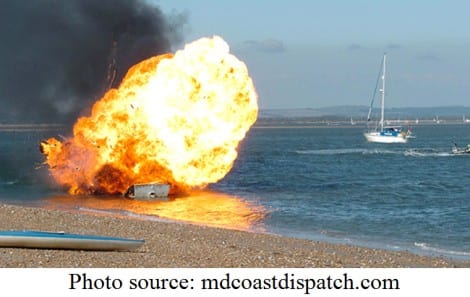
Item 7: Backfire Flame Arrester
All gasoline powered inboard/outboard or inboard motorboats must be equipped with an approved backfire flame control device. See pic above for reasoning.
Item 8: Sound Producing Devices
To comply with Navigation Rules and for distress signaling purposes all boats must carry a sound producing device (whistle, horn, siren, etc.) capable of a 4-second blast audible for at least half a mile. The Fox 40 pea-less whistle, developed for referees, is a popular option for kayakers, PWC operators, and produces quite a loud signal. I recommend that you have one attached to your PFD. That way if you end up in the water you have a readily available signaling device. The marine signal horn shown is a popular option for larger vessels. If you use that as your signaling device, I recommend that you also have a backup whistle on board as well.
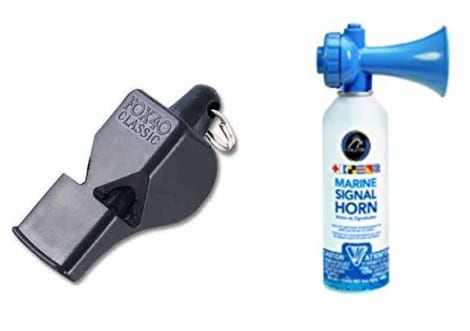
Item 9: Navigation Lights
All boats must be able to display navigation lights between sunset and sunrise and in conditions of reduced visibility. Boats 16 feet or more in length must have properly installed, working navigation lights and an all round anchor light capable of being lit independently from the red/green/white “running lights.”
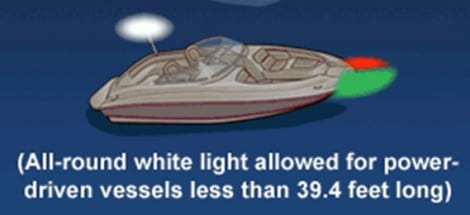
Item 10: Pollution Placard
Boats 26 feet and over with a machinery compartment must display an oily waste “pollution” placard. Here is an example of such a placard.
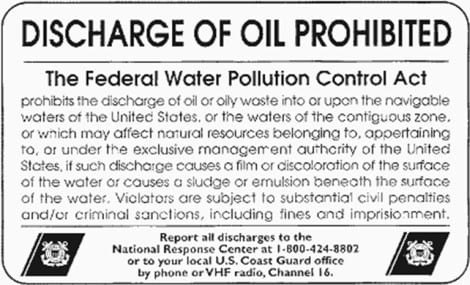
Item 11: MARPOL Trash Placard
Boats 26 feet and over in length operating in U.S. navigable waters must display a MARPOL trash placard. Ocean-going boats 40 feet and over must also have a written trash disposal plan available.
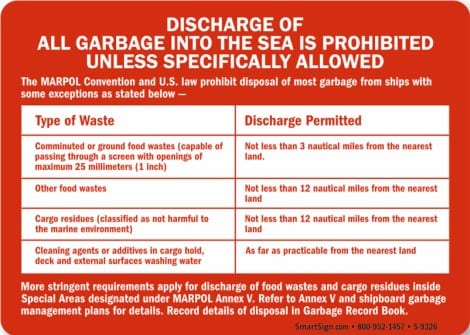
Item 12: Marine Sanitation Device
Any installed toilet must be a Coast Guard approved device. Overboard discharge outlets must be capable of being sealed. Boats operating in Texas must obtain a TCEQ certificate of compliance that must be displayed next to the Texas boat registration sticker. This item does not apply to portable toilets with no discharge outlets to the sea.
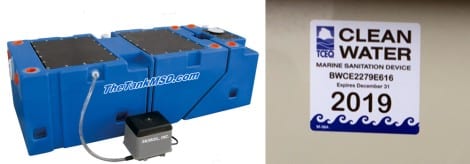
Item 13: Navigation Rules
Boats 39.4 feet and over must have on board a current copy of Navigation Rules. An electronic version is acceptable. If you have downloaded the Coast Guard app, then you have direct access to an electronic version of the Navigation Rules.
Item 14: State and Local Requirements
Most states, including Texas, have additional requirements that must be met. A boat must meet the requirements of the state in which it is examined. Here are the additional Texas requirements:
• Kill Switch lanyard must be attached to the operator
• TCEQ sticker required for installed toilets
• Texas Registration Sticker is required to be displayed for documented vessels
• Texas Registration Sticker must be aft of the registration numbers on both sides
Item 15: Overall Boat Condition
Inspect the following items to finish the safety check:
a. Deck Free of hazards and clean bilge: The boat must be free from fire hazards, in good overall condition, with bilges relatively clean and visible hull structure generally sound. The use of automobile parts on boat engines is not acceptable. The engine horsepower must not exceed that shown on the capacity plate.
b. Electrical Systems: Must be protected by fuses or manual circuit breakers. Switches and fuse panels must be protected from rain or water overspray. Wiring must be in good condition, properly installed and with no exposed areas or deteriorated insulation. Batteries must be secured and the positive terminal covered to prevent accidental arching. Boats with outboard engines are exempt from the covered post requirement. If installed, self-circling or kill switch mechanism must be in proper working order. All PWCs require an operating self-circling or kill switch mechanism.
c. Fuel Systems: Portable fuel tanks (normally 7 gallon capacity or less) must be constructed of non-breakable material and free from corrosion and leaks. All vents must be capable of being closed. The tank must be secured and have a vapor-tight, leak-proof cap. Each permanent tank must be properly vented.
d. Galley and Heating Systems: System and fuel tanks must be properly secured with no flammable materials nearby.
Summary
Although it is not designed to replace a Vessel Safety Check by a Certified Coast Guard Auxiliary Vessel Examiner, a self-check as outlined in this column can increase your chances of having a safe outing on the water. If you have ever had a Vessel Safety Check in the past, you have ready access to your Vessel Examiner, who can help you with any questions you may have about the Vessel Safety Check. Just look at the bottom of your previous Vessel Safety Check for the phone number of your Vessel Examiner, and don’t hesitate to call or text them with a question. The next column will cover the second half of the Vessel Safety Check, “Recommended and Discussion Items.”
For more information on boating safety, please visit the Official Website of the U.S. Coast Guard’s Boating Safety Division at www.uscgboating.org. Questions about the US Coast Guard Auxiliary or our free Vessel Safety Check program may be directed to me at [email protected]. SAFE BOATING!
[June-29-2020]

 Posted in
Posted in 























